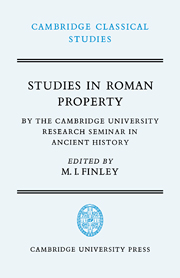Book contents
- Frontmatter
- Contents
- Preface
- 1 INTRODUCTION
- 2 SOME CONFIGURATIONS OF LANDHOLDING IN THE ROMAN EMPIRE
- 3 IMPERIAL ESTATES
- 4 CLASSICAL ROMAN LAW AND THE SALE OF LAND
- 5 THE CICERONIAN ARISTOCRACY AND ITS PROPERTIES
- 6 PRIVATE FARM TENANCY IN ITALY BEFORE DIOCLETIAN
- 7 URBAN PROPERTY INVESTMENT
- 8 AGRI DESERTI
- Notes
- Bibliography
- Index
2 - SOME CONFIGURATIONS OF LANDHOLDING IN THE ROMAN EMPIRE
Published online by Cambridge University Press: 05 June 2014
- Frontmatter
- Contents
- Preface
- 1 INTRODUCTION
- 2 SOME CONFIGURATIONS OF LANDHOLDING IN THE ROMAN EMPIRE
- 3 IMPERIAL ESTATES
- 4 CLASSICAL ROMAN LAW AND THE SALE OF LAND
- 5 THE CICERONIAN ARISTOCRACY AND ITS PROPERTIES
- 6 PRIVATE FARM TENANCY IN ITALY BEFORE DIOCLETIAN
- 7 URBAN PROPERTY INVESTMENT
- 8 AGRI DESERTI
- Notes
- Bibliography
- Index
Summary
If a map survived of part of the Roman world, say Italy in A.D. 100, showing the ownership and juridical status of land, it would reveal a number of different types. We should see for example some state land, some imperial land, and some city land, as well as a host of privately owned properties of varying size. This essay will attempt to assess the relative importance of the various types very briefly, before considering differences of size among private estates. The surviving evidence for private landownership is so distributed as to give a strong Egyptian bias to any exhaustive treatment of the empire as a whole. A selective discussion like the present one can at least attempt to avoid this imbalance.
Land generally fell into one of six categories (if both the nuances of legal title and the more complex situation in Egypt are ignored). There is no obvious hierarchy among these categories, but private land has deliberately been left until last here, because evidence for it is abundant enough to justify fuller consideration.
AGER PUBLICUS
The first type is ager publicus, land belonging to the populus Romanus, the Roman state. Such land, if cultivated, was generally in the hands of private tenants of the state. The extent of ager publicus was originally immense, since Rome's practice was to expropriate the land of conquered peoples, at any rate in name.
- Type
- Chapter
- Information
- Studies in Roman PropertyBy the Cambridge University Research Seminar in Ancient History, pp. 7 - 34Publisher: Cambridge University PressPrint publication year: 1976
- 48
- Cited by



